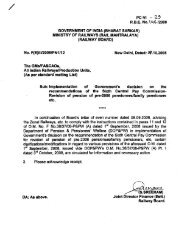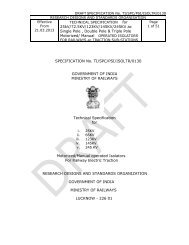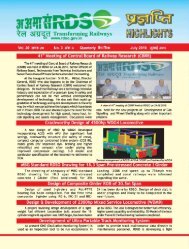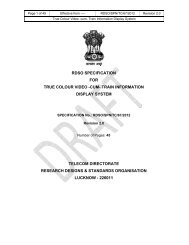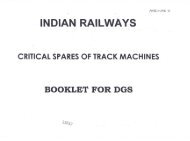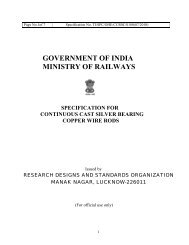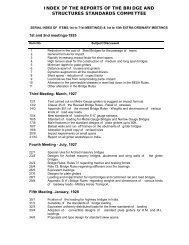Tender invited for Development of Train Collision Avoidance System
Tender invited for Development of Train Collision Avoidance System
Tender invited for Development of Train Collision Avoidance System
You also want an ePaper? Increase the reach of your titles
YUMPU automatically turns print PDFs into web optimized ePapers that Google loves.
ISO 9001: 2008 Effective from 18.06.2012 RDSO/SPN/196/2012 Version 3.1.1<br />
Document Title : Specification <strong>of</strong> <strong>Train</strong> <strong>Collision</strong> <strong>Avoidance</strong> <strong>System</strong><br />
MTBWSF Mean Time Between Wrong Side Failures<br />
OCIP Operation Cum Indication Panel<br />
OFC Optical Fiber Communication<br />
RAM Random Access Memory<br />
RAMS Reliability, Availability, Maintainability & Safety<br />
RDSO Research Designs & Standards Organisation<br />
RE Railway Electrification<br />
RF Radio Frequency<br />
RFID Radio Frequency Identification<br />
ROM Read Only Memory<br />
RS485 Recommended Standard 485<br />
RTS Ready To Send<br />
SIL Safety Integrity Level<br />
SOS Save Our Souls – A distress message<br />
SPAD Signal Passing at Danger<br />
SRS <strong>System</strong> Requirements Specification<br />
TCAS <strong>Train</strong> <strong>Collision</strong> <strong>Avoidance</strong> <strong>System</strong><br />
TIN Track Identification Number<br />
UNISIG European Signalling Industries<br />
3.2 Definitions:<br />
3.2.1 Acceptance Tests:Tests carried out on the equipment/ system <strong>for</strong> the<br />
purpose <strong>of</strong> acceptance <strong>of</strong> the equipment/ system.<br />
3.2.2 Banking/ Coupled mode: When, in addition to main leading loco, one or<br />
more locomotives are there in the train, other locomotives are said to be in<br />
Banking/ Coupled mode.<br />
3.2.3 Berthing Track: This is the designated section <strong>of</strong> the track in station section<br />
on which trains normally stop e.g. Plat<strong>for</strong>m lines etc.<br />
3.2.4 Block Section: The portion <strong>of</strong> the running line between two block stations<br />
onto which no running train may enter until Line Clear has been received from<br />
the block station at the other end <strong>of</strong> the block section.<br />
3.2.5 Cross Approval: A process <strong>of</strong> approval <strong>of</strong> <strong>for</strong>eign firms <strong>for</strong> their proven<br />
products/ systems through their Indian counter parts or supplier.<br />
3.2.6 Driving Cab: The cab where controls etc. are provided <strong>for</strong> the Driver to run<br />
the locomotive/ train.<br />
3.2.7 Driving Position: The position in the locomotive from where driver runs the<br />
locomotive/ train. Electric locomotives, some diesel locomotives, EMU,<br />
MEMU, DEMU etc. have separate driving cabs <strong>for</strong> either direction driving and<br />
there<strong>for</strong>e have one driving position in each cab. However, most diesel<br />
locomotives have only one cab having two driving positions i.e. one <strong>for</strong> each<br />
direction driving.<br />
3.2.8 Dynamic speed pr<strong>of</strong>ile: The speed-distance curve which a train may follow<br />
without violating the static train speed pr<strong>of</strong>ile and the end <strong>of</strong> movement<br />
authority. This curve depends on the braking characteristics <strong>of</strong> the train and<br />
the train length.<br />
3.2.9 End <strong>of</strong> Authority (EOA): Location to which the train is permitted to proceed<br />
and where target speed is zero.<br />
Signal Directorate RDSO/Lucknow Page 10 <strong>of</strong> 56



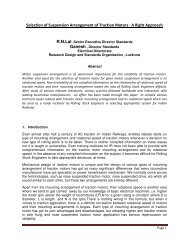

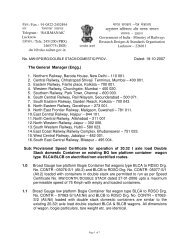
![Hkkjrljdkj] jsy ea= ky; vuql a/ kkuvfHkdYivkSj ekudlax Bu y ... - rdso](https://img.yumpu.com/21978459/1/184x260/hkkjrljdkj-jsy-ea-ky-vuql-a-kkuvfhkdyivksj-ekudlax-bu-y-rdso.jpg?quality=85)

